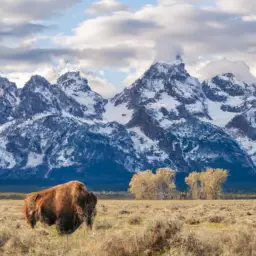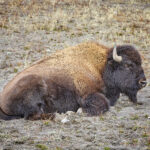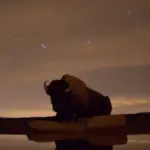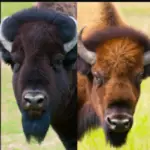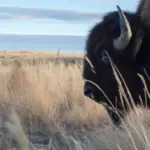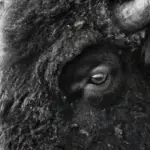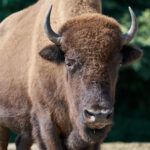If you’re planning a trip to Grand Teton National Park and have always wanted to see bison up close, then “Where To See Bison In Grand Teton” is the ultimate guide for you! This comprehensive product provides you with all the information you need to know about the best spots in the park to catch a glimpse of these majestic creatures. With detailed maps, insider tips, and stunning photographs, this guide will ensure that your bison sighting experience is a memorable one. So, pack your bags, grab your camera, and get ready for an adventure in the wild!
Overview of Grand Teton National Park
Grand Teton National Park is a picturesque and breathtaking destination situated in the northwest corner of Wyoming, USA. Covering an area of over 310,000 acres, it is home to stunning mountain ranges, pristine lakes, and a thriving ecosystem of diverse wildlife. Established in 1929, the park is renowned for its natural beauty, attracting millions of visitors each year. With its striking landscapes and abundant wildlife, Grand Teton National Park offers a unique opportunity to connect with nature and experience the wonder of the great outdoors.
Park History
Grand Teton National Park has a rich history that dates back centuries. It was originally inhabited by various Native American tribes, including the Shoshone, Bannock, and Blackfoot. In the 19th century, trappers and explorers ventured into the area, drawn by its abundance of wildlife and natural resources. In the early 20th century, efforts to preserve the park began, led by dedicated conservationists such as John D. Rockefeller Jr. and Horace Albright. Their advocacy and philanthropy played a crucial role in establishing the park and preserving its natural wonders for future generations to enjoy.
Main Attractions
One of the main attractions of Grand Teton National Park is the awe-inspiring Teton Range, a jagged mountain range that dominates the park’s skyline. The Grand Teton, the highest peak in the range, stands at an impressive 13,775 feet and offers breathtaking views for hikers and climbers. Another iconic feature of the park is the stunning Jackson Lake, a glacial lake that spans over 15 miles in length and provides opportunities for boating, fishing, and camping.
The park is also renowned for its abundant wildlife, including populations of bison, grizzly bears, moose, elk, and various bird species. The diverse ecosystem provides a thriving habitat for these animals, making Grand Teton National Park a haven for wildlife enthusiasts and nature lovers.
Wildlife in Grand Teton
Grand Teton National Park is teeming with a wide variety of wildlife, making it a paradise for animal lovers and wildlife photographers. Among the many species that call the park home, bison hold a special place. These magnificent creatures can often be spotted grazing in meadows or strolling along riverbanks. With their impressive size and distinctive appearance, bison are a highlight of any visit to Grand Teton National Park.
Understanding Bison in Grand Teton
Bison Population in Grand Teton
The bison population in Grand Teton National Park has experienced significant fluctuations over the years. At its lowest point in the early 20th century, the bison population in the park dwindled to a mere 20 individuals. Thanks to conservation efforts and successful reintroduction programs, the population has rebounded, and there are now over 500 bison roaming the park’s vast landscapes.
Characteristics of Bison
Bison, also commonly known as American buffalo, are massive creatures with a distinctive hump on their back and large, curving horns. They can reach heights of up to six feet and weigh over a ton. Their dark brown fur and short, stocky build make them well-adapted to survive harsh winters and navigate through deep snow.
Behavior Patterns of Bison
Bison are majestic and fascinating animals, exhibiting unique behavior patterns that reflect their social structure and natural instincts. They form tight-knit herds, often led by dominant males known as bulls. These herds are primarily comprised of females, or cows, and their young calves. During the breeding season, bulls engage in fierce battles for dominance, using their massive heads and horns as weapons.
Bison are herbivores, and their diet consists mainly of grasses and sedges. They graze on open meadows and move to lower valleys during the winter months in search of food. Although they may appear docile and peaceful, bison are unpredictable wild animals and should be respected from a safe distance.
Popular Bison Habitats within Grand Teton
Willow Flats
Willow Flats is a prime location within Grand Teton National Park to observe bison in their natural habitat. This expansive meadow provides ample grazing opportunities for these majestic creatures, and they can often be seen peacefully grazing or engaging in social interactions. The area offers excellent vantage points for wildlife viewing and is a popular spot for photographers looking to capture unforgettable images of bison against the stunning backdrop of the Teton Range.
Jackson Lake
Jackson Lake, one of the park’s main attractions, is also a favored habitat for bison. The lake’s fertile shores provide abundant food sources, attracting bison and other wildlife year-round. Visitors to Jackson Lake have the opportunity to observe bison as they move along the shoreline or wade in the shallows. The combination of the tranquil lake and the grazing bison creates a scenically stunning and memorable experience.
Lamar Valley
Lamar Valley, often referred to as the “Serengeti of North America,” is located in the northeastern section of the park and is renowned for its thriving wildlife population. Bison are an integral part of the ecosystem in Lamar Valley, and their presence adds to the biodiversity of the area. Visitors can witness herds of bison grazing in the expansive grasslands, or catch a glimpse of them crossing the Lamar River. The valley offers incredible opportunities for wildlife enthusiasts to observe bison in their natural habitat.
Hayden Valley
Hayden Valley, nestled between the Yellowstone River and Yellowstone Lake, lies just north of the Grand Teton National Park boundary. This vast valley is another cherished habitat for bison, attracting them with its nutrient-rich grasses and abundant water sources. Bison can often be spotted grazing alongside other wildlife, such as elk, deer, and pronghorn, creating a captivating and dynamic scene. With its picturesque landscapes and diverse wildlife, Hayden Valley is a must-visit destination for those hoping to encounter bison in Grand Teton National Park.
Guidelines for Safe Bison Viewing
Recommended Viewing Distance
When observing bison in Grand Teton National Park, it is important to maintain a safe distance to ensure both your safety and the well-being of the animals. The National Park Service recommends a minimum viewing distance of at least 25 yards for wildlife such as bison. This allows for a respectful and non-intrusive viewing experience while minimizing the risk of accidents or disturbances.
Safe Behavior Around Bison
While observing bison, it is crucial to respect their space and avoid any sudden movements or loud noises that may startle them. Bison have a keen sense of hearing and can be easily agitated if they feel threatened. It is advisable to remain calm and quiet, allowing the bison to go about their natural behaviors undisturbed.
What to Do if a Bison Approaches
In the event that a bison approaches you, it is important to stay calm and retreat slowly to a safe distance. Avoid turning your back on the animal, as this may be interpreted as a threat. Maintain a respectful distance and never attempt to touch or feed the animal. Remember, bison are wild and unpredictable, and it is best to observe them from a safe distance to ensure your safety and the integrity of their habitat.
Best Seasons to View Bison in Grand Teton
Summer Viewing
Summer in Grand Teton National Park offers fantastic opportunities to view bison in their natural habitat. As the snow melts, the park’s meadows become lush and green, attracting bison and other wildlife. The longer daylight hours and favorable weather provide ample time to explore and observe these majestic creatures. Be sure to bring binoculars or a zoom lens for an up-close view of these magnificent animals and capture incredible photographs.
Winter Viewing
Winter transforms the landscape of Grand Teton National Park into a winter wonderland, and bison still roam the snowy terrain. While the harsh conditions may limit visibility and accessibility to some areas, the park takes on a serene and ethereal beauty. Winter also offers the chance to witness the hardiness and resilience of bison as they navigate through deep snow and forage for food. Guided snowmobile or cross-country skiing tours can provide a unique and memorable experience of viewing bison in their winter habitat.
Spring and Fall Migration Patterns
Both spring and fall mark the seasons of migration for bison in Grand Teton National Park. During these transitions, large herds of bison move through the park in search of new grazing opportunities. These migration patterns provide incredible spectacle and present an excellent chance to witness the power and unity of these animals. By timing your visit during these seasons, you can have the opportunity to witness the awe-inspiring sight of bison on the move.
Bison Safari and Tour Options in Grand Teton
Guided Jeep Tours
For those seeking a personalized and informative experience, guided jeep tours are a popular choice. These tours offer the chance to explore the park’s most picturesque areas while benefiting from the knowledge and expertise of experienced guides. Equipped with comfortable vehicles, these tours ensure a smooth and enjoyable journey while maximizing wildlife viewing opportunities, including encounters with bison.
Wildlife Safari Tours
Wildlife safari tours provide a comprehensive and immersive experience in Grand Teton National Park. Led by experienced naturalist guides, these tours offer the opportunity to witness a wide range of wildlife, including bison, in their natural habitats. Operating in small groups, these tours provide ample opportunities for questions, photography, and an in-depth understanding of the park’s ecosystems and the animals that inhabit them.
Self-Drive Tours
For those who prefer a more independent and flexible experience, self-drive tours are an excellent option. Grand Teton National Park offers well-maintained roads and informative signage, allowing visitors to explore at their own pace. By using park maps and information materials, visitors can plan their own bison-focused itinerary and tailor their experience to their interests. Self-drive tours offer the freedom to stop, observe, and admire bison in their habitat while immersing oneself in the splendor of the park.
Camping and Accommodation Close to Bison Habitats
Campgrounds in Grand Teton
Grand Teton National Park offers a variety of campgrounds that cater to different preferences and camping styles. From picturesque lakeside campsites to rustic backcountry locations, there is a campground to suit every visitor. Several campgrounds are conveniently located near bison habitats, providing easy access to wildlife viewing opportunities. It is important to plan and make reservations in advance, as campgrounds can fill up quickly, especially during peak seasons.
Nearby Lodging Options
For those seeking a more comfortable and convenient stay, there are numerous lodging options available near Grand Teton National Park. From cozy cabins to luxury resorts, the surrounding areas offer a range of accommodations to suit different budgets and preferences. Staying in close proximity to the park provides the opportunity to maximize time spent observing bison and other wildlife without sacrificing comfort or convenience.
Wilderness Camping
For the adventurous souls looking to immerse themselves in the wilderness, wilderness camping is an exciting option. Grand Teton National Park offers designated backcountry camping areas where visitors can experience the solitude and rugged beauty of the park. By obtaining the necessary permits and adhering to park regulations, visitors can embark on multi-day backpacking adventures and camp near bison habitats, allowing for unparalleled opportunities to witness these magnificent creatures in their natural environment.
Other Wildlife to See in Grand Teton
Grizzly Bears and Black Bears
Alongside bison, Grand Teton National Park is famous for its bear population, including grizzly bears and black bears. These iconic creatures can be spotted in various parts of the park, particularly in areas with abundant food sources such as berry patches and streams. Viewing these majestic bears from a safe distance provides an unforgettable wildlife experience and highlights the importance of bear conservation efforts in the park.
Moose and Elk
Moose and elk are also prominent species in Grand Teton National Park and are often sought after by wildlife enthusiasts. Moose can be spotted near lakes and marshy areas, while elk are commonly found in open meadows and grasslands. Witnessing these magnificent animals in their natural habitats allows for a deeper appreciation of their grace and beauty.
Bird Species
Grand Teton National Park is a haven for birdwatchers, offering a multitude of bird species throughout the year. From bald eagles soaring overhead to vibrant songbirds found in the park’s forests, birdwatching enthusiasts are treated to a diverse array of avian life. Keep an eye out for species such as the American dipper, western tanager, and the rare trumpeter swan, among many others.
Wildlife Viewing Tips
When visiting Grand Teton National Park to observe bison or other wildlife, there are a few key tips to ensure a safe and respectful experience. It is advisable to bring binoculars or a camera with a zoom lens to enhance your view of the animals while maintaining a respectful distance. Responsible wildlife viewing includes refraining from feeding or approaching the animals, staying on designated trails, and leaving no trace of your visit. Following these guidelines helps protect the natural habitat and ensures the well-being of the park’s wildlife for future generations to enjoy.
Rules and Regulations for Wildlife Viewing in Grand Teton
National Park Service Rules
When visiting Grand Teton National Park, it is essential to abide by the rules and regulations set forth by the National Park Service to ensure the safety of visitors and the preservation of the park’s natural resources. These rules include maintaining a safe viewing distance from wildlife, refraining from feeding or approaching animals, and staying on designated trails. It is also vital to dispose of waste properly and respect closure areas or seasonal restrictions.
Local Ordinances and Regulations
In addition to National Park Service rules, visitors must also be aware of any local ordinances or regulations that apply within Grand Teton National Park. These may include rules regarding camping, fishing, boating, and recreational activities. Familiarizing oneself with these regulations ensures a hassle-free and compliant visit to the park.
Consequences for Rule Violation
Violating wildlife viewing rules and regulations in Grand Teton National Park may result in consequences, including fines, citations, or even being banned from the park. The safety of visitors and the preservation of the park’s wildlife and habitats are of paramount importance, and it is the responsibility of all visitors to uphold these rules. By respecting the regulations, visitors can contribute to the conservation efforts and help ensure a positive experience for everyone.
Are Bison in Nebraska Similar to Those in Grand Teton?
Yes, the best bison viewing spots in Nebraska offer a chance to see these magnificent creatures up close. While the bison in Grand Teton are also impressive, the ones in Nebraska have their own unique charm and are definitely worth a visit.
Conservation Efforts for Bison in Grand Teton
Bison Conservation Projects
Grand Teton National Park actively participates in bison conservation efforts, aiming to preserve the population and protect their natural habitat. These efforts include monitoring the bison population, managing their grazing patterns to minimize impact on vegetation, and implementing wildlife crossings to reduce the risk of accidents involving bison and vehicles. Through scientific research, public awareness campaigns, and collaborations with other conservation organizations, the park is committed to ensuring the long-term survival and well-being of the bison.
How Visitors Can Help
Visitors to Grand Teton National Park can contribute to bison conservation efforts by following the guidelines for safe wildlife viewing, respecting park regulations, and supporting educational programs and initiatives. By spreading awareness about the importance of conserving bison and their habitat, visitors can play a vital role in promoting responsible behavior and fostering a culture of conservation within the park and beyond.
Future of Bison in Grand Teton
As the future unfolds, Grand Teton National Park remains dedicated to the preservation and protection of the bison population. Ongoing conservation efforts, combined with increasing public awareness, hold the promise of a bright future for these iconic animals. By continuing to prioritize the welfare of the bison and ensuring their habitats remain intact, the park strives to create a harmonious balance between human activities and the needs of the wildlife that call Grand Teton National Park home.
In conclusion, Grand Teton National Park offers a unique and awe-inspiring opportunity to observe bison in their natural habitat. With its stunning landscapes, rich history, and thriving wildlife population, the park captures the essence of the American West. By adhering to safe wildlife viewing guidelines, respecting park regulations, and appreciating these magnificent creatures from a respectful distance, visitors can experience the wonder and beauty of bison while contributing to their long-term conservation. So, pack your binoculars, bring your camera, and embark on a memorable journey to witness the majesty of bison in Grand Teton National Park.

